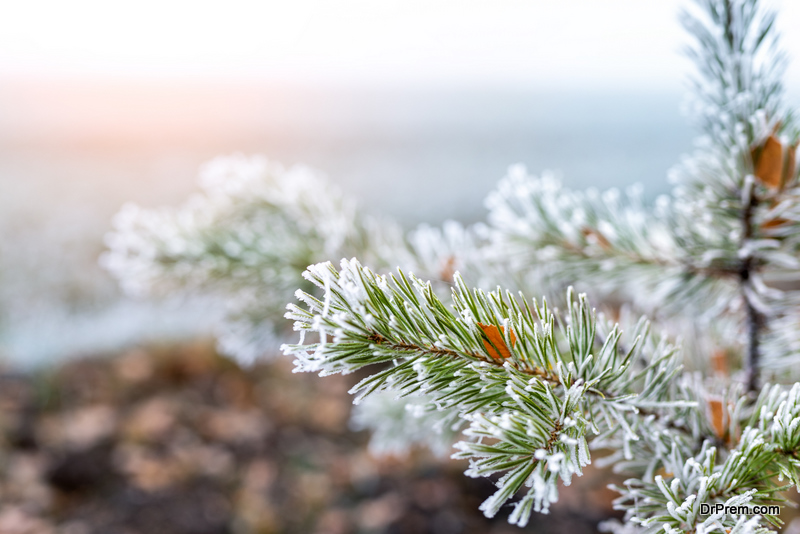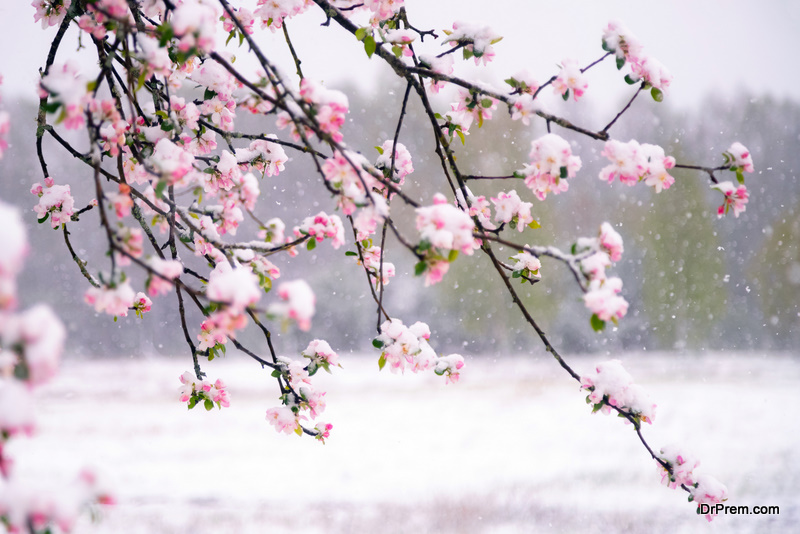Once the winter is over and we are ready to welcome in the Spring, most things seem bright and fresh. However, the winter elements might change all of this, especially if there is one last freeze on the way. Just when we thought the colder months were behind us, a late frost surprises us out of the blue. However, we are not the only living things shocked by the drop in temperature, as it can also have a damaging effect on our beloved trees too.
When the temperature drops, trees might get damaged due to frost. The frost often damages leaf buds and some trees even die. No matter what trees you have on your land, frost damage affects them all. Although a little frost won’t cause too much damage in some trees, it can cause a serious setback in others. However, there are a few things that you can do to help your trees make a full recovery.
Drastic changes in the weather can stress us out, especially when we didn’t see it coming. Well, trees are similar. A lot of trees will sprout again during the year after being damaged, however, some trees won’t. Some trees are more vulnerable than others, especially fruit and flower trees.
How does Frost Damage Certain Trees?
 All trees are different, and all trees react to frost differently. Let’s take a closer look at how frost can damage some of the most popular trees:
All trees are different, and all trees react to frost differently. Let’s take a closer look at how frost can damage some of the most popular trees:
- Lilac: Frost damage causes new growth to go brown shortly after the freeze. Although Lilacs are pretty good at managing frost damage, you might come across a small amount of browning.
- Japanese Maples: The leaves on these trees may have gone black and brown after a late frost. The leaves will probably fall off after time and eventually grow back. Don’t expect the leaves to be as strong or as healthy looking the second time they grow back on the tree. If the tree only had buds before the drop in temperature, you should be fine.
- Redbud: Frost damage tends to turn leaves on a Redbud to turn burn and you can expect them to wilt over time. However, if your Redbud is healthy and strong the maples should sprout once the temperature improves.
- Magnolia: If you notice broken stems and black leaves on your Magnolia tree you might have an issue, however, with a small bit of TLC your tree can go back to the way it was.
If you think your trees are dead after the late frost, before removing them you should consider treating them first, you might be able to save the tree.
How can you Protect Trees before a Late Frost?
If trees have been struggling to survive before a late frost hits, they are much more vulnerable in comparison to healthier trees. One of the easiest ways of protecting your trees from frost is by keeping a close eye on the weather forecast. If you see that there is going to be a late frost, water your trees the night before. Others like to cover their trees with burlap, however this only works on smaller trees.
Once you are out of the woods and you feel there are going to be no more late frosts, you may have to water your trees on a regular basis. Consider watering your trees once a week.
A lot of people have great success by mulching their trees. This provides the trees with some much-needed nutrients. Don’t forget to prune your trees, and get rid of any dead stems.
How can you tell if your Trees are Dormant or Dead?
 It might surprise you, but trees work really hard throughout the year to bring a lively aesthetic to our property. It’s understandable that trees take a break and relax over the winter months. The dormant season is vital for trees because this is when they prepare for the warmer months and conserve energy. However, just because you can’t see any leaves on the tree branches or activity, doesn’t mean the tree has died. Plus you don’t have to be a tree expert to see if your tree is dead or alive. Follow these three steps to see if there is still life left in your trees:
It might surprise you, but trees work really hard throughout the year to bring a lively aesthetic to our property. It’s understandable that trees take a break and relax over the winter months. The dormant season is vital for trees because this is when they prepare for the warmer months and conserve energy. However, just because you can’t see any leaves on the tree branches or activity, doesn’t mean the tree has died. Plus you don’t have to be a tree expert to see if your tree is dead or alive. Follow these three steps to see if there is still life left in your trees:
- Can you notice any budding life? Examine your tree thoroughly and see if there are any small leaf buds. Even during the coldest times of the year, you should be able to notice small buds. If you notice a lot of little buds your tree should look alive and well in the Spring.
- Examine the trunk of the tree: Just like tree leaves, barks have their own cycle. A bark is constantly replacing itself while it is growing. It’s a good sign If you notice fresh bark growing. However, if you notice that the tree’s trunk has been shedding its layers without replacing it with new layers you could be in trouble. This is a major sign that your tree is in decline. Examine the trunk for cracks, which is another sign that your tree is on the way out.
- Scratch test: Get one of the tree’s twigs, and scratch it with a small, sharp knife. If the first layer under the bark is bright green and slightly moist your tree should be fine, however, if you notice a brown, brittle layer your tree might have died.
Luckily, there are a lot of experts readily available to help with maintaining your trees. Before removing any tree, talk with experts like Trufast for advice.
What can you do with Trees that have been Damaged by Late Frost?
Unfortunately, if you notice the aforementioned signs caused by frost, there’s very little you can do. However, most trees will be able to recover on their own. Experts do advise people to take better care of their trees on their property to help increase their lifespan. The healthier the trees are, the better they will handle a drop in temperature.
If you haven’t taken proper care of your trees before a late frost, don’t worry, it might not be the end of the world. The damage caused during a late frost doesn’t last forever in most trees. In some areas where trees experience late frosts almost every year, the trees should be able to tolerate the sudden change in the weather.
Conclusion
Taking care of your trees yourself can often cause a lot of headaches. That’s why so many people are hiring expert tree surgeons to help them manage their trees on their land. Most trees are big, heavy objects, and removing them can prove dangerous.
By hiring a professional tree company, they will take into account the dangers of removing a tree. Tree surgeons with a lot of experience will have the knowledge, advanced equipment, and chemicals to remove the tree safely. They will also be able to tell you if your tree needs to be removed or not. They will be able to tell the condition of your tree and if there’s a possibility of saving the tree.
If you do decide to remove the tree yourself, make sure you use the proper safety equipment including gloves, a hardhat, protective goggles, heavy work boots, etc. Be extra careful using chemicals and fertilizers when removing a tree.
Article Submitted By Community Writer




